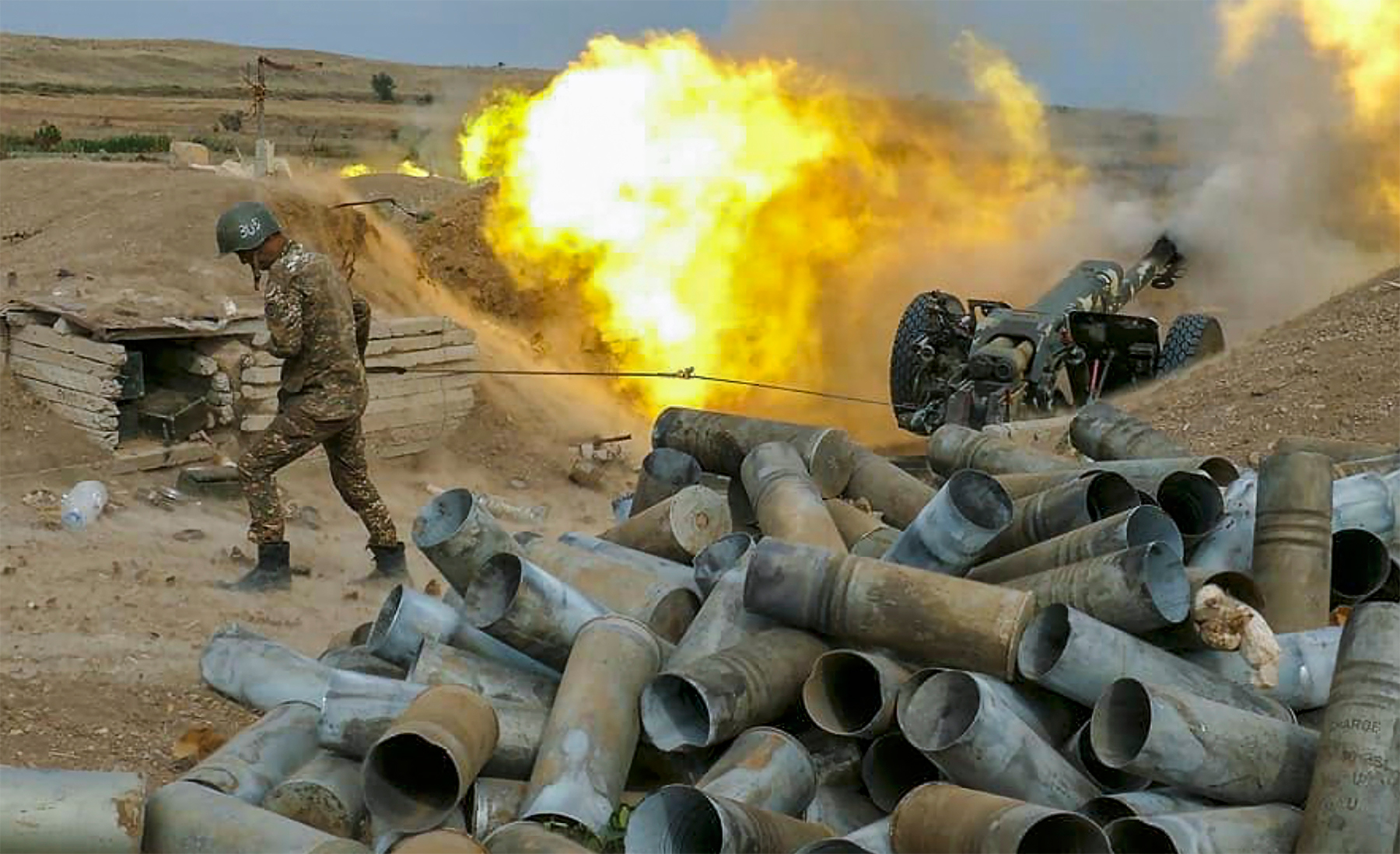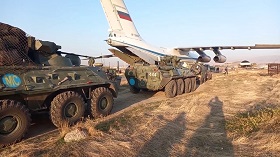On November 9, Russia signed a peace statement with the leaders of Armenia and Azerbaijan, ending the most recent war in Nagorno-Karabakh. Overall, Moscow emerged as the clear winner by ending hostilities, introducing peacekeepers, and maintaining its central role in the vital Caucasus region. However, Russia's direct intervention in the Karabakh conflict with the November peace statement also bears echoes of much earlier history.
On July 24 (August 4), 1783, at the southern Russian fortress of Georgiyevsk, representatives of Russian Empress Catherine the Great and Georgian King Erekle II concluded a historic agreement. The Treaty of Georgiyevsk established the eastern Georgian Kingdom of Kartli-Kakheti as a Russian protectorate, signaling the beginning of Russia’s southward expansion into Transcaucasia.
The move infuriated neighboring Persia, which had long seen Kartli-Kakheti as its dependency. Moreover, Russian commitment to the Georgian kingdom proved inconsistent. In September 1795, Persian Shah Agha Mohammad Khan Qajar, seeking to re-subjugate the recalcitrant Georgians, marched on Tiflis (Tbilisi) and ruthlessly plundered and destroyed the city, massacring its inhabitants.
By the time the Russians had received word of what had transpired, it was too late. Catherine was furious and belatedly launched a campaign against Persia. However, her death in 1796 precluded her from taking further action. Meanwhile, Agha Mohammad, who was scheming to remove the Christian Georgian and Armenian inhabitants from the Caucasus, was assassinated by two servants in Shushi (Shusha), in Karabakh, in 1797.
Amid these developments, it became apparent to St. Petersburg that in order to adequately defend Kartli-Kakheti and guarantee the safety of its inhabitants, it needed to establish a firm foothold in the kingdom. In 1800, Russian Tsar Paul I annexed Kartli-Kakheti and, in 1801, Tsar Alexander I incorporated it directly into the Russian Empire. At the time, the eastern Georgian kingdom’s connection to Russia was tenuous. Only a single road—the Georgian Military Road—connected Russia to its new Caucasian acquisition.
Serious compromise on the part of both Yerevan and Baku is essential for the peace over Karabakh to be a genuine and durable one. Haughty declarations of “total victory” from the Azerbaijani side, accompanied by provocations, cannot be considered a blueprint for a lasting solution. At this moment, it is absolutely critical for Moscow to establish stability and parity between the sides.
After over 200 years, Russia’s commitment to the Caucasus remains firm. The region is a natural fortress protecting Russia’s southern flank, and thus, it falls squarely into the category of “vital interests.” Therefore, from Moscow’s point of view, peace in Karabakh also means peace in Dagestan, Stavropol, Krasnodar, and other neighboring republics and territories of the Russian state. To quote Comrade Sukhov’s line from a famous Soviet film, “the East is a delicate matter”. More specifically, in today’s context, Karabakh is a delicate matter, especially for the Kremlin. It is now up to Russian President Vladimir Putin and Foreign Minister Sergey Lavrov to keep the peace in this strategically vital part of the former USSR.
On November 9, Russia signed a peace statement with the leaders of Armenia and Azerbaijan, ending the most recent war in Nagorno-Karabakh. Overall, Moscow emerged as the clear winner by ending hostilities, introducing peacekeepers, and maintaining its central role in the vital Caucasus region. However, Russia’s direct intervention in the Karabakh conflict with the November peace statement also bears echoes of much earlier history.
Echoes of the Past
On July 24 (August 4) 1783, at the southern Russian fortress of Georgiyevsk, representatives of Russian Empress Catherine the Great and Georgian King Erekle II concluded a historic agreement. The Treaty of Georgiyevsk established the eastern Georgian Kingdom of Kartli-Kakheti as a Russian protectorate, signaling the beginning of Russia’s southward expansion into Transcaucasia.
The move infuriated neighboring Persia, which had long seen Kartli-Kakheti as its dependency. Moreover, Russian commitment to the Georgian kingdom proved inconsistent. In September 1795, Persian Shah Agha Mohammad Khan Qajar, seeking to re-subjugate the recalcitrant Georgians, marched on Tiflis (Tbilisi) and ruthlessly plundered and destroyed the city, massacring its inhabitants.
By the time the Russians had received word of what had transpired, it was too late. Catherine was furious and belatedly launched a campaign against Persia. However, her death in 1796 precluded her from taking further action. Meanwhile, Agha Mohammad, who was scheming to remove the Christian Georgian and Armenian inhabitants from the Caucasus, was assassinated by two servants in Shushi (Shusha), in Karabakh, in 1797.
Amid these developments, it became apparent to St. Petersburg that in order to adequately defend Kartli-Kakheti and guarantee the safety of its inhabitants, it needed to establish a firm foothold in the kingdom. In 1800, Russian Tsar Paul I annexed Kartli-Kakheti and, in 1801, Tsar Alexander I incorporated it directly into the Russian Empire. At the time, the eastern Georgian kingdom’s connection to Russia was tenuous. Only a single road—the Georgian Military Road—connected Russia to its new Caucasian acquisition.
Over the next several decades, Russian military action in the Caucasus would focus on working to secure Kartli-Kakheti. To the west, it expanded into Imereti, Abkhazia, Mingrelia, and Guria. To the east, it marched on Ganja (later known as Elizavetpol) and Baku. To the south, it snatched up Karabakh and, at the end of the 1820s, Yerevan, Etchmiadzin, Nakhichevan, and the Talysh region. To the north, in a long-running campaign that lasted throughout the 19th century, Russia absorbed the North Caucasus.
The Path Forward
Like Kartli-Kakheti over 200 years ago, Karabakh provides Russia with a platform to solidify its position as the ultimate power broker in the Caucasus. It also presents Moscow with both new opportunities and dilemmas. Now that it has established a firm foothold in Karabakh with its peacekeepers, its next step will be to focus on enhancing the security of the area. In this regard, Russia’s greatest assets are the Armenian inhabitants of Karabakh. Without these inhabitants, the presence of the Russian peacekeeping force and by extension, Russian control over Karabakh, becomes less tenable. Therefore, Moscow aims to ensure that Karabakh Armenian refugees who fled during the war return to their homes, in order for the peacekeeping mandate to be a success. The Karabakh Armenian authorities have already begun to work with Russia in this regard by providing incentives for refugees to return.
However, in order to make the refugees feel safe and to ensure a steady return, Moscow may have to consider the option of expanding its zone of control to encompass parts of Karabakh that are now either controlled by Azerbaijan or will soon be under Azerbaijani control. These would include the district of Hadrut and the city of Shushi (Shusha), as well as two districts located outside the boundaries of the Soviet-era Nagorno-Karabakh Autonomous Oblast—Kelbajar and Lachin. The latter two mountainous districts are bounded by the high Mrav mountains to the north, Armenia to the west, Russian-guarded Karabakh to the east, and the Lachin corridor to the south.
The addition of these areas to the Russian zone of control would firmly ensure the safety of the Karabakh Armenian refugees, encouraging many more to return. It would also strengthen Russia’s diplomatic position as a neutral arbiter and further enhance its physical position in the region, securing key supply and communication lines. After all, as the historical lessons of Kartli-Kakheti demonstrate, it is extremely difficult to maintain control of a region through a single road, whether it be the Georgian Military Road, or the Lachin Corridor. Moreover, Russian control over Kelbajar would effectively resolve the new border dispute over the Sotk gold mine.
Finally, rather than concede the “Caucasian Jerusalem” of Shushi (Shusha) to either Armenian or Azerbaijani control, Russia may consider maintaining it as a “neutral city.” Similarly, in the ideal Russian scenario, the final status of Karabakh itself would be determined in a neutral manner. If the Kremlin genuinely seeks a just and lasting solution to this protracted problem, then it may leave Karabakh outside of both Armenian and Azerbaijani control. Instead, it could maintain it as an independent entity controlled by Russian peacekeepers, allowing Armenians and Azerbaijanis to co-exist and live together again. Historical and cultural monuments—both Christian Armenian and Islamic—would be restored and preserved under Russian protection. These would include the Dadivank and Amaras monasteries.
The road to such a peace is certainly not easy, but Moscow understands that decisive steps must be taken to ensure (1) that any peace is lasting peace, (2) that its position as a regional arbiter is preserved, and (3) that a balance of power and parity between the sides is restored. If the current statement is left without significant revisions, then it will ultimately serve to undermine both the peace and Russia’s position in the region. In order to maintain its viability, major revisions and enhancements to the pre-existing November statement in the interests of the Russian state are necessary, for the sake of the long-term peace and stability of Transcaucasia, as well as the Armenian and Azerbaijani peoples.
Serious compromise on the part of both Yerevan and Baku is essential for the peace over Karabakh to be a genuine and durable one. Haughty declarations of “total victory” from the Azerbaijani side, accompanied by provocations, cannot be considered a blueprint for a lasting solution. At this moment, it is absolutely critical for Moscow to establish stability and parity between the sides.
After over 200 years, Russia’s commitment to the Caucasus remains firm. The region is a natural fortress protecting Russia’s southern flank, and thus, it falls squarely into the category of “vital interests.” Therefore, from Moscow’s point of view, peace in Karabakh also means peace in Dagestan, Stavropol, Krasnodar, and other neighboring republics and territories of the Russian state. To quote Comrade Sukhov’s line from a famous Soviet film, “the East is a delicate matter”. More specifically, in today’s context, Karabakh is a delicate matter, especially for the Kremlin. It is now up to Russian President Vladimir Putin and Foreign Minister Sergey Lavrov to keep the peace in this strategically vital part of the former USSR.







